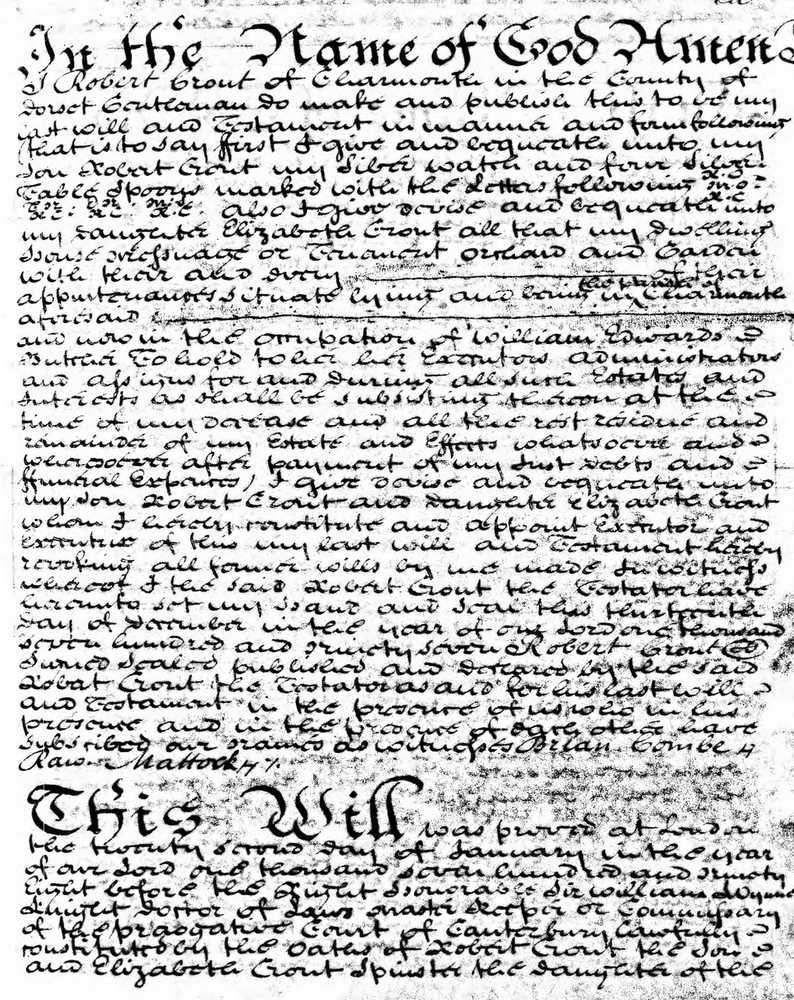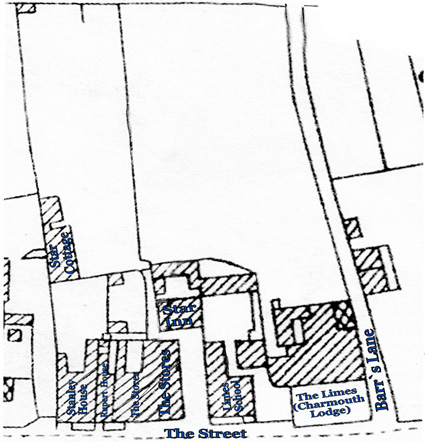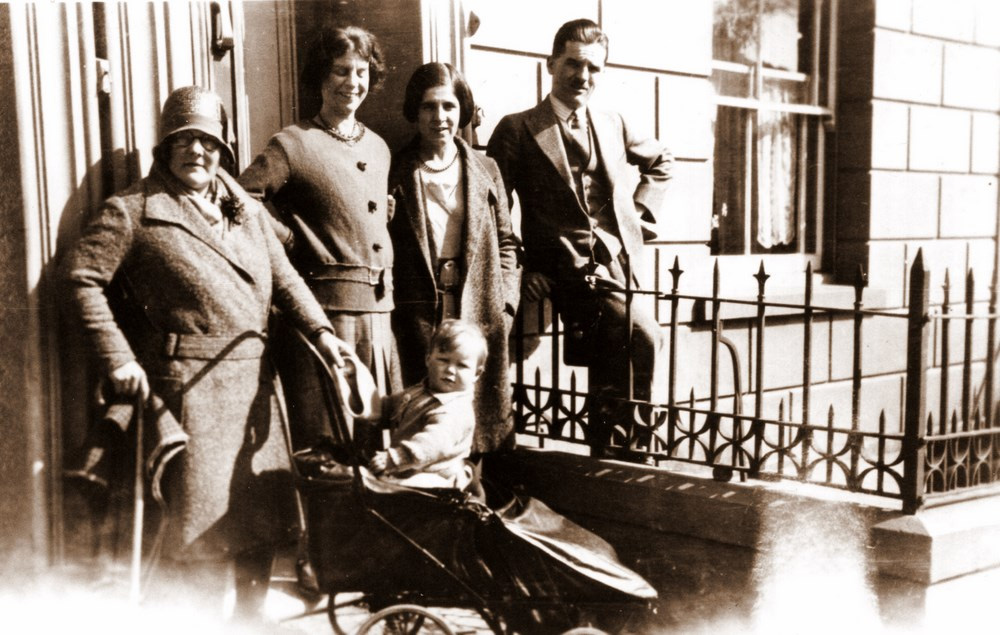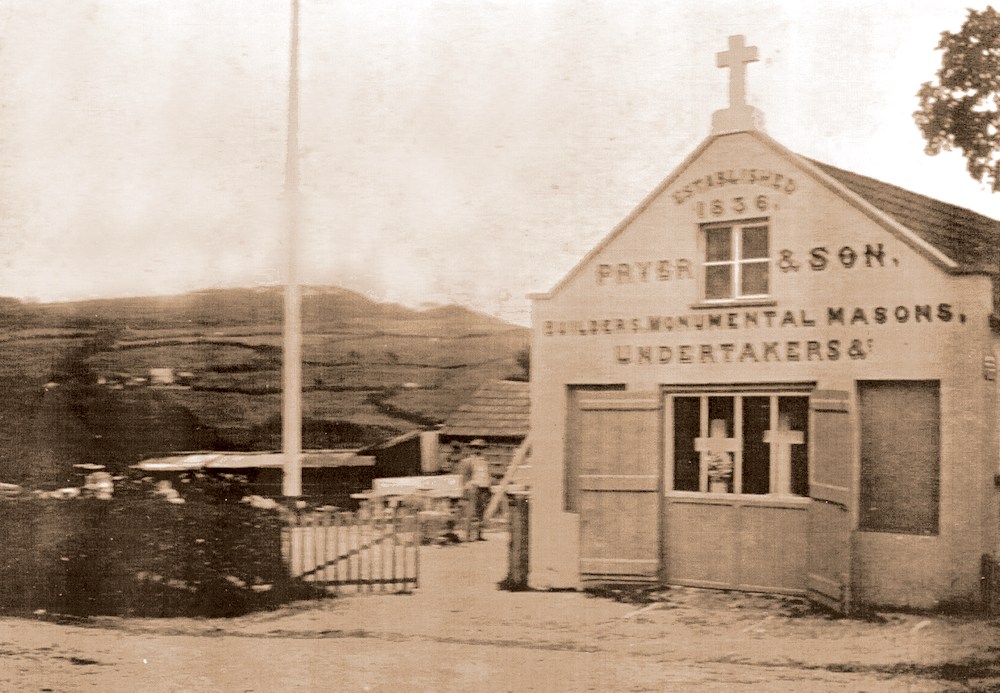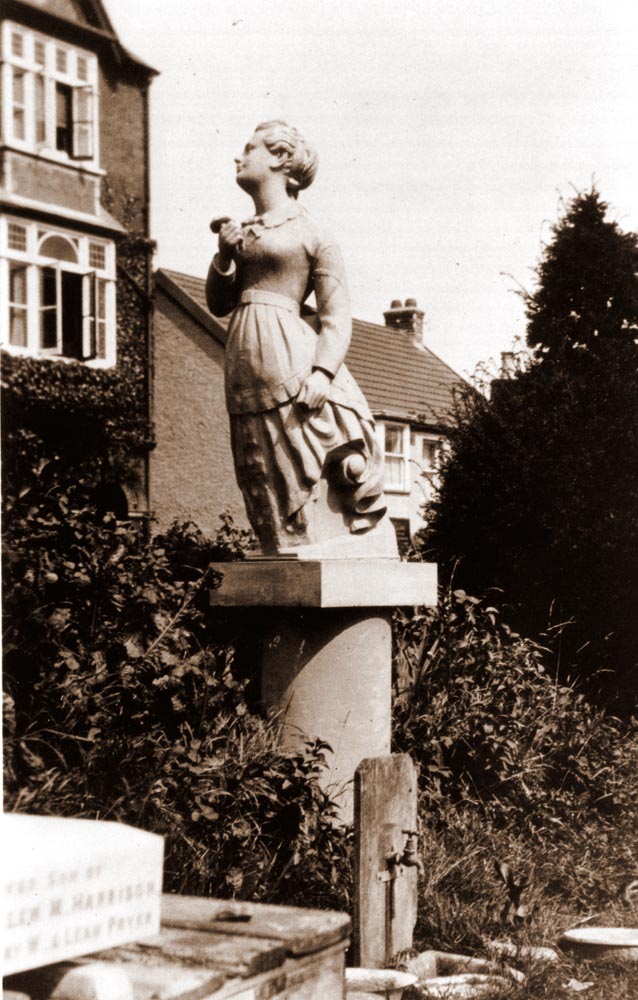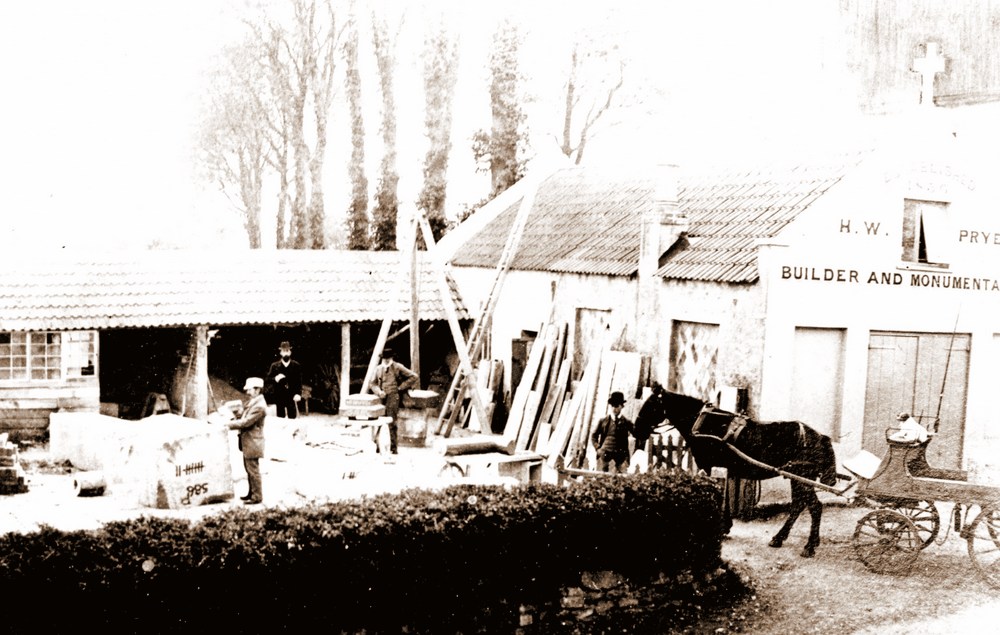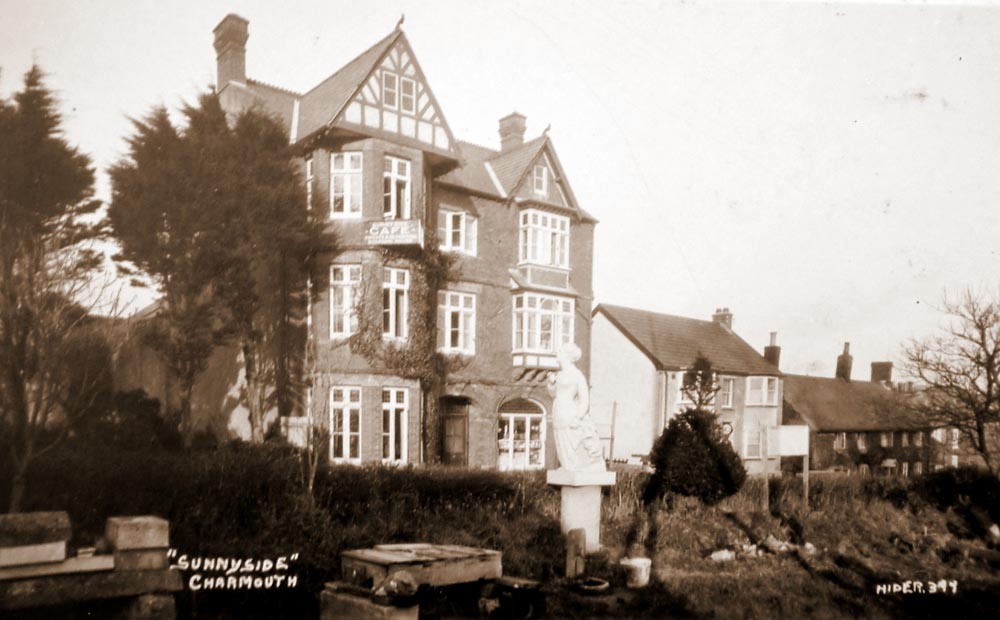Click on images or Charmouth Home to return back.


What you see today is the work of Giles Pryer, a Mason living in the end house, who rebuilt it after a devastating fire in 1864. He was to call it “ Prospect Place ” , a board with this name used to hang above the Stores entrance. No photographs or paintings exist of the earlier thatched structure, the only record we have to go on is the Village's Tithe Map of 1841, which is quite detailed, and shows a structure covering almost the same area. But the layout is different with the middle section subdivided into two units in what is today - Rupert House and Breeze. In the same year, a Census was carried out for the country and it has been possible combining the information with the map to find out a great deal about the occupants. To go back further in time becomes more difficult, but in Charmouth`s case we are fortunate that there is a continuous Poor Rates listing from 1805 until 1832 and Land Tax receipts from 1780 until 1832. Other records include Jury Lists, Wills, Directories and Deeds which are very useful, and more recently many Newspaper archives have been placed on line by the British Library. The Dorset Family Centre has an especially informative website produced under the auspices of ancestry.co.uk . It was after ploughing through their large collection of Wills for Charmouth that I came across one for William Edwards for the year 1757. This was to prove to be the missing link in understanding the early history of Prospect Place and the family that lived there. For William describes himself as a Common Carrier, with a wagon for delivering goods. His family owned the 3 Crowns, now the Coach and Horses opposite, which was a stop off for Coaches and Wagon from London to Exeter and would have supplied him with his trade. His Will is surprisingly detailed and shows him having seven children. He leaves a number of fields which he had purchased from Mr. Hutchins and Mr. Ffloyers to his offspring. He also distributes his clothes and possessions, including “ Seven Cyder Casks ” to Thomas Edwards. But most important to my research was the line:
“ I give to my wife, Margaret Edwards the House that was her Fathers`, Samuel Cornelius for her natural life only and after her death to my Daughter, Dinah Edwards".
This was a revelation as in that sentence was the clue to its early history. For I knew from the Land Taxes that William Edwards had a substantial property in the village and after his death in 1767, his wife, Elizabeth is shown briefly as owner, but then I lost track. But with Parish Records and other information was able to build up a family tree linking the various families to the Edwards.
It would seem that the building is indeed associated with the family called Cornelius. Their earliest reference is in 1641, when Alexander Cornelius appears on the Protestation List for the village. His son Samuel is born in 1672 and the Parish Records show him marrying Mary Street in 1706. The following year a daughter, Margaret is born to them.
Margaret Cornelius goes on to marry William Edwards in 1739 and they have a large family. On the death of her father, Samuel, in 1745, Margaret inherits the family house. She brings up her family there with her husband, William. This is the house that is referred to in the Will, and on her death in 1784, it had indeed been inherited by her daughter Dinah, who was married to an Excise Officer from Dalwood in Devon, with the unusual name of Crout, which appears in the record books. They were to have two children, Robert and Elizabeth. It was the latter in 1799 who was to inherit the property on the death of her father - Robert. Two years later she married the twenty three year old Francis Bradbeer. He was the son of Joseph Bradbeer, who had originally come from Blandford Forum and was for a number of years the Landlord of “ The Three Crowns ” opposite. It would seem that there was to follow a devastating set of events. In 1804 tragedy struck the family when Joseph lost his Wife Mary, his daughter Maria Richards as well as her husband. The following year it was to be his son Francis, who was to mourn the loss of his wife, Elizabeth. As a result he decided to make a fresh start and moved to Woolwich to join his brother, Joseph jnr. who was based there in the Artillery. He was to re-marry shortly after and open a Tailors shop there before moving with his family to Salisbury. It is his father ' s name,Joseph that now appears in the Poor Rates Lists. They show that the property was in two parts at that time and what is the Charmouth Stores (Nisa) formed the smaller area and the other part was let separately. In 1806 it is shown that Mr. Osborne occupies this part, but more importantly the other section was to be the Post Office and Store which Joseph Bradbeer was to open in that year, the start of over 200 years of trading from the same site. Indeed, some of the original building is incorporated today in the rear of the property. This was to be a momentous year, for he is to marry his third wife, Lydia Margrie who is 25 years younger and together they run the Post Office and Store. He is still renting the Three Crowns from William Edwards but soon after gives up the lease after 20 years as landlord there. The Royal Mail would pass through the village each day and stop briefly at the Inn. The letters would have special hand stamps, some of these letters have survived from this time. Until the Penny Black appeared in 1840, People would often refuse letters as they would have to pay on receipt, unless prepaid. This is shown by an advert in the Western Gazette in the year 1809 which mentions the Charmouth Post Office as the forwarding address for a property to let by a Mr. Jerson, who makes it clear that “ only post-paid letters will be attended to ” . A Census for the village in 1812, describes Thomas Browning, who occupies the west part of the building as a “ Coach Man ” and Joseph Bradbeer, who is in the east part as a “ Post Master ” . On his death in 1821 at the age of 71 he leaves his estate to his wife, Lydia, which includes a small cottage that used to stand in the grounds of the church and was at one time Stables for the Manor House opposite. She continues running the shop and letting the other part and its stables. It is interesting seeing Thomas Galpin Carter renting part, as he was the Artist for many of the early images and prints of the area. She is later described as a Shopkeeper in the General Post Office Record Book when she takes on the role of Post Mistress. The Pigot`s Directory for 1830 lists her as a Shopkeeper and dealer in Sundries. Her life is to change again in 1832, when at the age of 57 she marries the local school teacher, William Dodson Watts. In the same year, she lets the western part of Prospect Place to John Carter, who is a Carpenter, with a workshop in the building which houses “ The Pharmacy ” today. He later opens a shop in his part of Prospect Place. Unfortunately Lydia`s marriage is a disaster and her husband a spendthrift soon gets through her legacy. There is a reference to William Watts being dismissed by the Post Office in 1839 and John Carter, Grocer becomes the Post master. William finally leaves Lydia and she has to sell all her property to clear his debts. I have been fortunate to locate the advert for the Auction in May 1841, which describes the lots in detail. She even loses the freehold of her shop where she is living when it is bought by the wealthy Wootton Fitzpaine Farmer, Benjamin Swaffield. Lydia later moves her busines across to the small cottage that once stood in front of the church, where she stays until selling her interest in 1860 to the trustees, who demolish it to extend their yard. Sadly she loses her eyesight and dies a pauper at the age 89, six years later.
The auction of 1841 gives some of the tenants the opportunity to buy their premises, and both Giles Pryer and John Carter become freehold owners and prosper. But in 1864 there is a devastating fire that sweeps through the building and almost destroys the surrounding properties as well. The newspaper ' s report at the time are quite descriptive about the thatched roof and how after initially being put out by the Lyme Regis Fire Engine, the fire returned the following day, even more destructive. It is rebuilt in brick and tiles by Giles Pryer who divides it into four units which are named: Charmouth Stores, Ashyford House, Rupert House and Stanley House. They are numbered 1 to 4 Prospect Place and I have endeavoured below to provide a potted history.
Charmouth Stores No. 1 Prospect Place
This was to be a Post Office as well as a Stores for its first hundred years and was one of the earliest in the country. For the Royal Mail as we know it today was initiated by John Palmer of Bath in 1787 with its first fast service from Bristol, via Bath to London. The following year he began running his coaches from Exeter to London and they would have passed through the village. The Three Crowns was to become a Coaching Inn, owned by William Edwards but run by Joseph Bradbeer from that time, for almost twenty years. The trade was so important that it was renamed “ The Mail Coach Inn ” and subsequently the “ Coach and Horses ” . He opened the Post Office in part of the present building in 1806, which due to a tragic chain of events already described was inherited by his son, Francis. On Joseph`s death in 1821, the business continued with his wife, Lydia who rented part of the building to John Carter, who opened a shop there in 1832. After a disastrous second marriage to William Watts, she loses her properties, which are auctioned in 1841. The Tithe Map and Census for the same year, show her, now single, running a shop in what is now Charmouth Stores, with John Carter taking over as Post Master, in the central section of the building. Directories of the time advertise the business as that of a Grocers, Post Office and Builders. Sadly John was to die young in 1855 and leaves the shop, three houses in Catherston and a house in Sea Lane (Lower Sea Lane) to his wife who continues running the business with the son, John William (born 1841) who later takes it over.
In 1862 the Post Office and Stores is in the hands of John Hawkins, who advertises: Teas of the Finest Growth and Flavour, Superior Coffee and Superior British Wines. He continues for a while, but by 1870 George Mortimer is the owner and is described as a Linen & Woollen Draper, Grocer, Tea Dealer & Provision Merchant, China, Glass, Earthenware & Brush Warehouse and Post Master. He eventually sells the business to Edward Archer Vince in 1888. Old Photos of the time show a massive hoarding on the side of the building with a long list of all the goods and services that were offered inside. John Baker from Steyning in Sussex succeeded Edward in 1896, but by then George Holly was the new Post Master running this business from Wistaria on the Street, where it was to remain for the next 40 years. Times were to be hard for him, especially with a severe downtown in trade during the First World War and he eventually put the business up for sale in 1918.
It was to be purchased by William John Dampier who had been a Grocery Clerk for the Department Store of Boons and Sons of Dorchester. His son, Donald was to follow him into the business and take over in 1954 and in due course his grandson Ronald joined them and eventually ran it from 1970 until 2000.The business has evolved with the times and provides Villagers and Visitors today with a wide range of goods. It is now over 200 years old and would have opened at a time when Nelson had just won the Battle of Trafalgar for the country. The earlier building goes back to at least the 17 th century when it was owned by the Cornelius family. Part of this structure is believed to be incorporated in the rear of the property.
Ashyford House. No. 2 Prospect Place
This part of the building is now the Gift Shop – Breeze run by the owners of the Charmouth Stores (Nisa). It has been a shop for over 100 years, run in conjunction with its neighbour. It seems from the 1901 Census that John Baker was the shopkeeper for both properties. But before the 1864 fire it had formed part of the Carters Shop. Afterwards the 1871 Census shows Christina Hutchings running a small school there, three of her pupils are shown as boarding with her. A decade later, the Census show that Henry Burroughs, a Gardener from Hawkhurst is living there with his wife. He continued to reside there until his death in 1900 aged 88. His Will shows him owning the freehold of both his house as well as the adjoining properties of Charmouth Stores and Rupert House. These were subsequently purchased by Alfred Gapper Pass -a wealthy Bristol businessman who lived at Wootton Fitzpaine Manor. Rupert House. No. 3 Prospect Place.
This property had prior to the 1864 fire, been part of the Carters area, but afterwards it was extended back considerably as a separate holding. James Wellman, aged 34, moved in shortly afterwards as the following year he brings out a Guide and Directory for Charmouth, which must have been a success as a second edition came out later in the year. It is to run to six editions, the final one being in 1880. He also trades as a Watchmaker, Jewellers and a Stationers from the premises. Both he and his sister, Martha, who lives with him, had moved there from their parents ' home in Hawkhurst. James Wellman died in 1881 aged just 52, and Miss Wellman continued with her “ Fancy Repository ” . Reginald Pavey tells us, “ that her shop also sold toys and newspapers and had a counter across the room and a large cupboard with a glass front in which were her toys. There were no railings; pedestrians in those days enjoyed the full extent of the pavement ” . Martha Wellman died in 1896 and George Cooper, aged 56 who is described as a Retired Military Official is shown as living there with his family. The 1911 Census describes the house as unoccupied, but the electoral register a decade later has Percival and Rosa Woolford residing at the address.
Stanley House. No. 4 Prospect Place.
The History of this house is basically that of one of Charmouth`s most successful families – The Pryers, who were to live and own it for almost a century. They left their mark on the village with a number of buildings including the Heritage Centre, Pryers Villas, at the bottom of Barrs Lane and of course Prospect Place. A dispute over the Election Results of 1842, bought Giles to Court as a witness, his testament is very revealing as follows: “ I am a Mason and Plasterer living in Charmouth about 15 years. I have some back offices and a shed behind my house. I was paying £ 12 a year rent, but bought it on 27 th May last, when it was put up for auction. I have occupied it 4 years as tenant and paid Poor, Church and Highway rates. I have a parlour, kitchen in front, two rooms over and a large lobby which had room enough for a bed to stand on and take in lodgers in the summer months ” . He would have been just 30 when he bought the freehold of his house and the subsequent ten yearly censuses show him and his wife, Elizabeth, then aged just 20 bringing up seven children there. When his neighbour, John Carter gave up his Carpentry business to open his Shop, it was Giles Pryer who was to take over and eventually buy his workshops, which is now the building occupied by “ The Pharmacy ” and the surrounding field, where the shops are today. After the 1864 fire, which is said to have started under the thatched roof in his part of the building, he had the job of rebuilding the present property. He appeared to have kept ownership of his part and on his death in 1881 passed it over to the son Harry William Pryer who remained there for the rest of his life. Harry was known by the nickname of Pussey and went on to own a large number of properties and fields in the village. These included the land on both sides of the Street where the shops are today, which were built after his death in 1931. An auction ten years before of some of his estate includes Minson ' s Common, Double Common and Sea View in Lower Sea Lane as well as a number of houses. Old Postcards of the time show his Stone Masons workshops and yard spread over the field known as Pear Close which covered the corner of The Street and Lower Sea Lane as far as Wesley Close and the Abbots House. Their House in Prospect Place has two front doors as one led to their office.
Neil Mattingly .

In the Name of God Amen - I William Edwards of the Parish of Charmouth in the County of Dorset, Common Carrier being in good bodily health and of sound disposing mind and memory do make this my last Will and Testament in manner and form following, first and principally I commit my soul and the hands of God who .. It my body .. to be recently Buried at the discretion of my Executrix herein after named. As to my worldly goods I give and dispose of in the manner following. First I give and devise to my dear and loving wife, Margaret Edwards, all those two Closes and Fields which were Hutchings containing 8 acres be the same more or less and also those two other fields I bought and purchased of Mrs Ffloyer containing 8 acres, be the same more or less, lying being in the Parish of Whitchurch Canonicorum in the County of Dorset aforesaid for her natural life only and after her death I give to my son Samuel Edwards the Close part of Hutchings which is 5 acres with a proviso herin after mentioned. I give to my son, Stephen Edwards the... Close part of Hutchings which is 3 acres. Provided my son, Samuel Edwards should die unmarried, then I give the Close part of Hutchings which is 5 acres to my son, Stephen Edwards and if my son Stephen should die unmarried.
I then give to my son Benedick Edwards, the Close part of Ffloyers above mentioned which is 5 acres with a proviso therein afore mentioned, which is 5 acres with all proviso therein afore mentioned. I give to my son James Edwards the lesser Close part of Ffloyers which is 3 acres provided my son Benedick Edwards should die unmarried then I give the Close part of Ffloyers which is 5 acres to my son James Edwards and if my son James Edwards should die unmarried then I give the close part of the said Ffloyers which is 3 acres to my son Benedick Edwards but provided my sons Benedick Edwards should live to enjoy these closes part of the said Ffloyers which is 5 acres then that close I give my said son James Edwards the sum if £ 70 to be paid him by his brother, my sin Benedick Edwards. I then give to my son Thomas Edwards the feather bed that he did lay upon with the furniture him do belonging. I also give my said son Thomas Edwards 7 Cyder Casks. Item. I give to my son William Edwards the sum of £ 20.
Item. I give to my wife Margaret Edwards the House that was her Fathers, Samuel Cornelius for her natural life only and from after the death of my said wife, Margaret Edwards I give devise & bequeath the said House to my daughter Dinah Edwards and all the rest and residue of my lands, tenements, & hereditaments with the appurtenances thereto belonging and not thereby otherwise disposed of together with all my household of what kind so ever ( except what is before herby given) Plate, Bonds, Stock of my estate as well within as without Door together with all my other Properties to me belonging I give devise& bequeath to my above named wife, Margaret Edwards whom I thereby constitute and appoint my whole and sole Executrix of this my last Will and Testament herby revoking all former Wills. In witness whereof the said William Edwards have hereunto set my hand this fourth day of March 1757. William Edwards.
On the 4th May 1767 This Will of William Edwards deceased was proved by the oath of Margaret Edwards, the Widow of the said deceased.

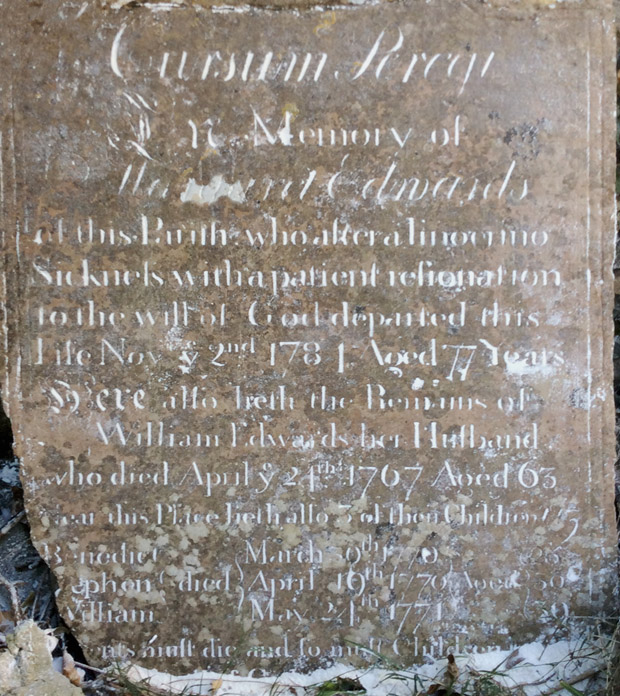

To be sold the residue of a certain long term of years, wherin about 900 years are yet to come and unexpired, subject to an Estate. therin subject to the life of a person aged about 70. All those 2 Closes of rich meadow ground called HUTCHINS`s, containing 8 acres situated in the parish of Whitchurch Canonicorum, in the County of Dorset, adjoining to the turnpike-road leading from Charmouth to Bridport, late in the estate of William Edwards, deceased.
For which purpose a survey will be held at the house of Thomas Edwards, known by the sign of the 3 Crowns, in Charmouth aforesaid, on Thursday the 2nd day in December next, by 2 o`clock in the afternoon.
In the mean time, for further particulars, apply to Mr. Clarke, attorney at law, at Chard, in the county of Somerset, and for a view of the premises, to the said Thomas Edwards.
Chard, Novemeber 13, 1773.
Although part the building housing the present Charmouth Stores is ancient, we are only really interested in the original owner of the shop 200 years ago. This gentleman is Joseph Bradbeer. He originates from Blandford Forum and is shown to marry Elizabeth House there in 1774 and they have at least 3 children - Francis Henry ( 1778) Joseph( 1780) and Maria. The first mention we have of him is in 1790 when his wife Elizabeth sadly dies and is buried in St.Andrews Church, Charmouth. The Parish Records show that was to marry Mary Rogers in the same year.
There are no records of him in the village until 1793 when is is shown as the Landlord of "The Fountain Inn", now Charmouth House at the junction of Higher Sea Lane. Thomas Bidwell is the owner of this historic property which he inherited from his Father- Obadiah. But Joseph is only there briefly before taking over its competitor as landlord in 1796 at "The 3 Crowns", which is now known as the "Coach and Horses", next to the Church on the Street. The Inn is then owned by William Edwards who had recently inherited it from his Grandmother - Hannah Newbury, who ran it for many years. Joseph is shown in the Land Tax records for the village as renting Newlands Farm from Mrs Coade and also Charmouth Meadows from Rev. Brian Coombes. He has also shown as owner of "Balsons" , which may well be the former name of the large thatched building that was sub dived within, next to the Old manor House. In 1801 his son, Francis Henry marries local girl Elizabeth Crout and their property is refereed to as "Crouts" in the Poor rates and also supplied them an income as part was shown to be let by them.
All seems to be going well for the Bradbeers, but tragedy was to hit them in 18o4 when his beloved daughter, Maria Richards and her husband are buried within a week of each other at the beginning of the year, Tragically, his wife, Mary is shown to have also died before the year is out. Just two years later, Joseph at the age of 58 embarks on his third marriage to Lydia Margrie, who is 27 years younger than him.The follwing year he is shown as leaving the 3 Crowns and this is no doubt a career change as in 1815 a Census taken of the village describes him as The Post Master, which he is operating with his wife Lydia. This is also the year that by tracing back the Poor Rates Lists for the village it can be seen that he is to transfer his business to the portion of the building that is Charmouth Stores(Nisa) today. Both he and his son Francis, had owned the group from 1808. The Rates book show that they were renting the larger part to Thomas Browning and Joseph was living in the smaller part. In 1810 there is an advert from Thomas referring to the Inn as the. Coach and Horses to Let. But in 1813 he lets the Coach House and Stables at the back to William Stephens, who was the subsequent Landlord of the 3 Crowns. When Thomas Browning gives up his lease, Joseph is shown to take on the larger portion and lets his former home to David Legg. The Poor Rates lists now show Joseph Bradbeer (4 1/4d), David Legg ( 2 1/4d) and William Stephens ( 2 1/4d). This was to remain his and his wives home for subsequent years and corresponds with Nisa today, as is shown is abstracts from the lists shown below. In 1816, ten years after opeing his new Post Office, his neighbour, Ann Kitt is to open a general Stores inpart of her Father, Jacob Ridley Kitts property now much altered and called "Little Lodge", whilst Steven Atkinson demolishes a number of workshops and builds the Limes ( Charmouth Lodge) adjoining it. The former Coach House and Stables at the rear are later bought by the tenant- Willaim Stephens, landlord of the 3 Crowns and in time becomes the Star Inn, which may explain its postion back from the Street. Unfortunately the new business takes its toll on the elderly Joseph Bradbeer and his passes away in 1821, aged 69. His grave can still be seen near the east wall of the Churchyard, another stands nearby for his family. We are fortunate in that his Will has survived and is quite descriptive, relating to the contents and rooms in his shop and house. The neighbouring shop set up by Ann Kitt is short lived and she sells it 2 years later to James Welch from Lyme Regis.who in due course sells it to his neighbour William Stephens in 1822 and he rents it to Charles Cookney who is described as a Linen draper in Pigots Directory of 1830. The same Directory shows that Lydia has diversified and is now running a Grocers, the foreriunner of the Stores today. There is an intersting entry in the Post Office Records for 1827, showing Lydia as a Shopkeeper. But her life was to change when she met and married William Dodson Watts, a school teacher, who had recently arrived in Charmouth. They subsequently marry and he is shown as Postmaster. But their marriage is short lived and her fortunes go into decline, so that by 1841 the Tithe Map shows that she has sold her property to Thomas Swaffield of Wootton Fitzpaine and is renting her own shop from him. In 1841 she sold her main shop to John Carter, who was to build up the Stores. He had been a carpenter and was shown as carrying out his trade in the building that was to become subsequently Bragges Stores on the corner of Lower Sea Lane.
Opposite the Manor House in the eighteenth century were stables, which were no longer required by James Warden when he went to live at Langmore, and were bought by the Rev.Thomas Puddicombe of Branscombe. the brother of his wife for £ 100. The stables were later converted into a small dwelling house and butcher's shop. They were subsequently bought by Joseph Bradbeer of the Inn in 1805 and were left for her life to his widow. She in 1832 married William Watts who deserted her after nine years. Lydia Watts was later to keep a small shop and sold sweets to the children on their way to school, and by 1861 she was blind and very infirm and was receiving 2/6 relief from the parish. The Ecclesiastical Commissioners paid her £ 13 to procure a surrender in her old shop and premises and she died in 1865 ninety years of age. The shop was empty for five years, was a disfigurement to the village, and obstructed the view of the church it was then pulled down in 1866. Besides this old cottage the village Pound had to be moved. It stood near the cottage and John Hawkshaw, lord of the manor, gave permission to have it moved to the top of the village, on the corner of Old Lyme Hill and Old Lyme Road. At the same time probably, the Stocks which had been purchased in 1828 were done, away with. What happened to the Pillory mentioned by Roberts is not known.
Valuable freehold and leasehold properties
To be sold by auction by Mr. R. Fowler, at the Mail Coach Inn in Charmouth aforesaid on Thursday the 27th day of May 1841, at 5 o' clock in the afternoon, subject to such conditions that will be produced, either together or in such Lots as may be agreed upon at the time of the sale.
Lot 1- All that Messuage or dwelling house with the Garden behind the same, eligible situated in the centre of the village of Charmouth, opposite to the Mail Coach Inn, now in the occupation of Mr.Giles Pryer, as a yearly tenant, at the tent of £ 12 per annum.
Lot 2 - All that Messuage or dwelling house, adjoining the above, with the commodious and old established Grocers Shop thereto belonging and adjoining, and the Garden and Warehouse immediately behind the same, now in the occupation of Mr. Carter, at a yearly rent of £ 24, under a lease of which 4 1/2 years is unexpired.
Lot 3 - All that Messuage or Dwelling House, adjoining the above now used as a Lodging House, together with the newly erected Messuage or Dwelling House, now let as two distinct tenements, adjoining to and behind the Lodging House, all which said last mentioned premises are in the occupation of yearly tenants, and are of the yearly value if £ 20.
Lot 4 - all that well known and much frequented Public House, adjoining close to the last mentioned premises, called or known by the name of the Star Inn, now in the occupation of Mr.E. Smith, as a yearly tenant, at a rental of £ 18 per annum.
Lot 5 - all that Cottage and Dwelling House together with the large and productive Piece of Garden ground in which it stands, comprising considerably more than a quarter of an acre, situate at the back of the premises previously adverted to and now in the occupation of Mr.John Jeffrey, as a yearly tenant at a rental of £ 10 per annum. The above Premises are partly Freehold and partly Leasehold for 2,000 years.
Lot 6 - All that Messuage or Dwelling House, on the side of Charmouth Street, and adjoining to the Church Yard there, lately occupied by Mr. John Love as a dwelling house and Butchers Shop, at a yearly rental of £ 20. N.B. These Premises are held for the Life of a person aged about 65 years, and a Life of near the same age is insured in £ 380. In the West of England Insurance Office, to the be git of which the Purchaser of this lot may, if desirable, become entitled.
Lot 7 - all that Freehold House and Garden situate in the Parish of Bothenhampton, now in the occupation of Mr. Roberts, as a yearly tenant, at a rental of £ 10 per annum.
For viewing the Premises, and for further particulars, apply to Mr. Carter, Grocer, on the Premises, Charmouth, Mr.Hillman, Lyme or

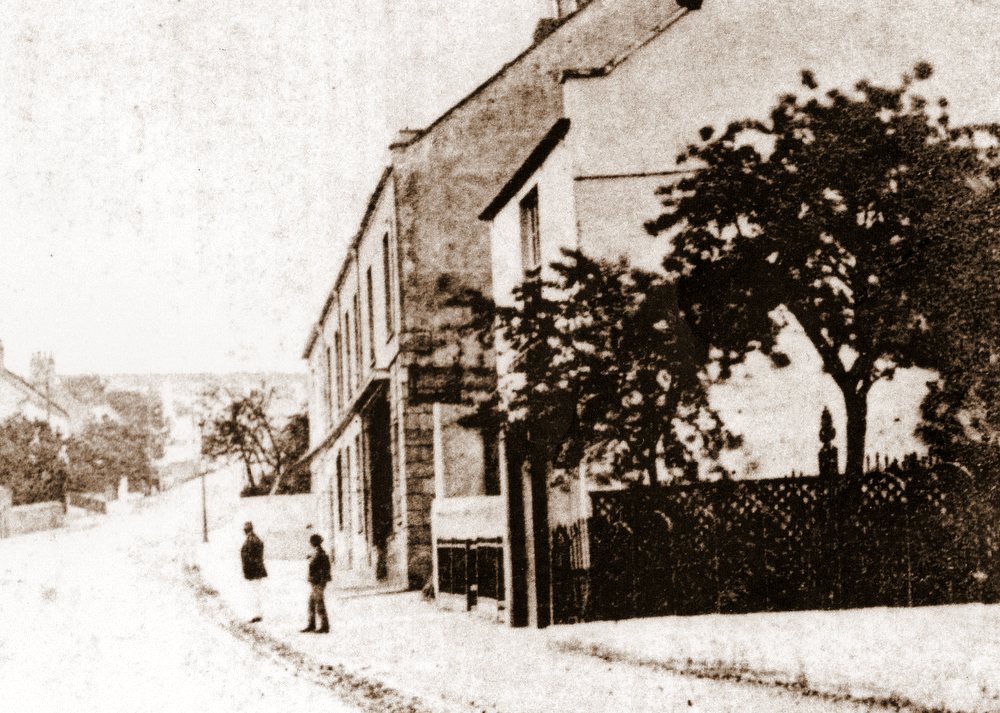



























| 1832 Lydia Bradbeer( aged 57) marries William Dodson Watts, a School Teacher, John Carter and his wife are witnesses |



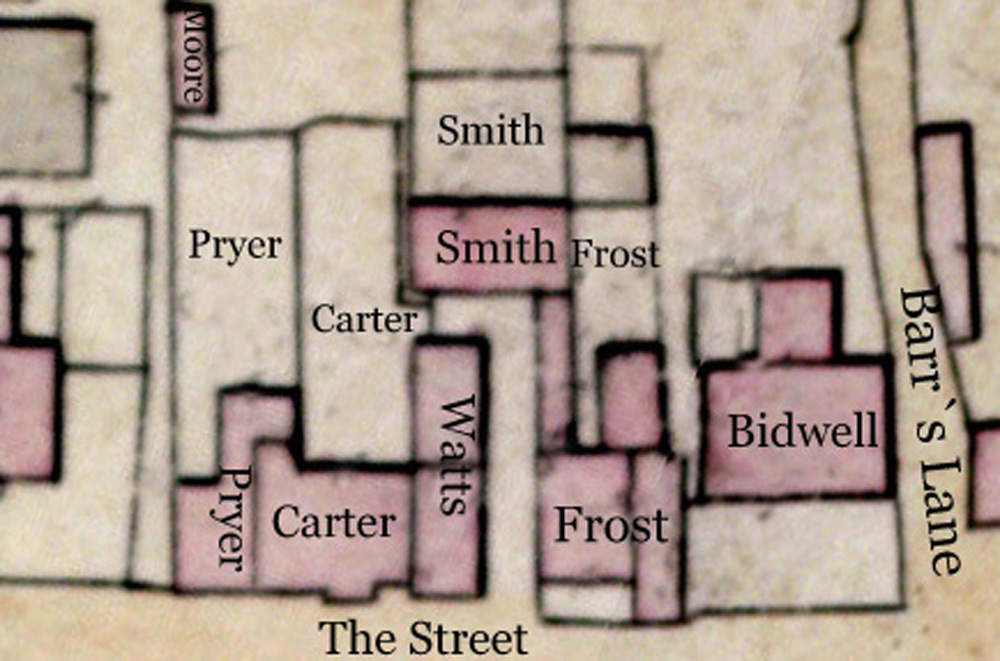
No. |
Occupier |
Age |
Owner |
Description |
A |
R |
P |
| 55 | John MOORE | 55 | Francis Henry WARING | House & Garden | - | 1 | 8 |
| 54 | Giles PRYER | 30 | Giles PRYER | House & Garden | - | - | 12 |
| 53 | John CARTER | 38 | John CARTER | House & Garden | - | - | 14 |
| 52 | Lydia WATTS & another | 60 | Benjamin SWAFFIELD | Houses | - | - | 4 |
| 51 | Edward SMITH | 54 | Edward SMITH | House & Court | - | - | 5 |
| 50 | John FROST | George BIDDLECOMBE | House & Garden | - | - | 13 | |
| 49 | Thomas BIDWELL | 72 | Painknell BIDWELL | House & Garden | - | 2 | 30 |

